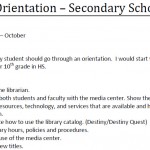A couple of people rightfully asked me questions about this, and I realized it was a subject that I had originally intended to incorporate into my manifesto, but in my rush of revolutionary fervor I forgot about it. So, since we all love sequels and series so much, I here present the second episode of my cataloging saga. It even has a paranormal character (a ghost), and it ends with a cliffhanger.
Two Parts:
1) Philosophy of Merging Titles
2) Q. I am cataloging a book and there is a title record for another version of it in the system that doesn’t match my copy’s ISBN. What do I do?
Philosophy of Merging Titles
When we talk about merging titles records together, this can mean several things:
- Merging together duplicate title records that are in our system that refer to the exact same edition with the same ISBN(s).
- Merging the title for the hardcover edition of a book with the title for the paperback version that comes out a year or two later. Both ISBNs are included in the combined record.
- In the case of books that have been around for awhile and receive new printings, it can mean merging title records for several editions together and having one record, with the ISBNs of all editions included in that one record.
In the circumstances where we merge titles together, we use the publication year of the most recent printing. In some cases I guess this could make the “average collection age” of certain schools creep forward to look a little bit newer than it truly is, but it is definitely not going to make it look older. It also could cause some slight confusion in the super-rare situation that we have a patron who is very concerned with bibliographic details and needs one specific edition of a fiction book.
However, our philosophy is that the day-to-day benefits of merging the various printings of the same title together far outweigh these potential problems. We want to leave those hardcore description details of printings and editions to rare book collectors and university archives, and keep things streamlined and simple for our patrons.
Redwall comes to mind as a good example of the great benefits of merging, because it has been around for 20+ years, has been reprinted several times, and is part of a long series. More importantly, it is a beloved book of my childhood. If a student wants to check out Redwall, certain covers of certain editions might look more or less appealing to him, but ultimately he doesn’t or shouldn’t really care if he gets the 1988 hardcover or the 1995 paperback or the 2002 Scholastic Book Fair version or the 2008 20th Anniversary Commemorative Edition of Redwall. They are all the same text, there are no significant content changes, just changes in the cover art and the physical dimensions of the book, and whether it is hardcover or paperback. If he searches for Redwall in the catalog, and the library has copies of Redwall in all of these editions, he should not have to click through three or four different title records before he truly knows if there is a copy of the book available for him to check out. Likewise, the librarian shouldn’t have to double check each of these titles for the purpose of holds, and then decide randomly which title to place on hold on for the student. Chances are a different edition will be returned first, but it won’t go on hold for the student because it is on a different title record. And if the student wants to see which other titles of the Redwall series are available in the library, just multiply the confusion of clicking through three or four titles by 22, which is the number of titles there are in the Redwall series. If all the printings of each title were merged into one title record, all of this hassle for the student and the librarian would disappear. He can quickly scroll through all the books in their series order in Destiny. He can get a hold placed on the book he wants with ease. Everyone is happy, except for perhaps the archivist/archaeologist ghost that haunts every library.
The only complication which we haven’t figured out how to neatly deal with yet is the situation of old books/classics that have passed into the public domain and so have all kinds of editions and variations published by dozens of different publishers over the years. Until we figure out a good solution we won’t be merging these types of titles together, because many of them have more significant differences than simple reprintings, such as unabridged vs. abridged, retellings, large illustrated editions, introductions by various authors, supplementary essays, footnotes, &c. Likewise, the significant updates and revisions in new editions of nonfiction titles cause us to only very rarely merge nonfiction titles across editions.
Q. I am cataloging a book and there is a title record for another version of it in the system that doesn’t match my copy’s ISBN. What do I do?
A. Go ahead and add the “A+” record for your edition (ISBN) of the book. We definitely want the information for the newest version of the book in our catalog, so don’t just add copies to an old edition of the title, and don’t add a new ISBN to an old title record. It’s the whole new wine/old bottles thing. I would tell you to notify me about these duplicates when you create them or come across them, but right now there are so many duplicates already that this notification would not really be a good use of any of our time. (If I can get things under control in a few months I will inform you, and at that point I would appreciate you spotting these new duplicates for me.)
There is one exception to this current don’t ask/don’t tell policy – if you have copies of multiple editions of the same book in your library and they are sitting on multiple different titles records in your library and you would like them merged, then do let me know. Do this for something specific that is causing you problems right now (such as if it is a popular book and your holds are getting messed up by the multiple titles), rather than giving me a long inventory of every problem with the titles you use in your school.
There. We’re done.
P.S. Don’t merge titles yourself unless you are really confident that you are doing the right thing. Unique ISBNs need to be copied over one by one into new 020 a tags in the MARC Edit view, and you need to compare several fields to make sure that the titles should in fact be merged, and to determine which is the best or most complete record. If anything in my last sentence makes you feel nervous or confused, you should probably not be merging titles until you’ve learned more.
Joshua Whiting
Library Media / Educational Technology
Granite School District
2500 South State Street
Salt Lake City, UT 84115
jwhiting@graniteschools.org
385-646-7128





